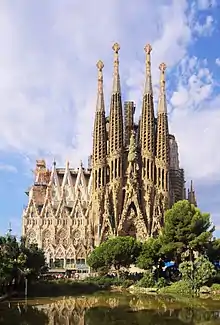Moorish architecture
Moorish architecture, is a style within Islamic architecture which developed in the western Islamic world, which included al-Andalus (Muslim-ruled Spain and Portugal between 711 and 1492), Morocco, Algeria, and Tunisia.[1][2][3][4][5] The term "Moorish" comes from the Western European designation of the Muslim inhabitants of these regions as "Moors",[6][7][8] which itself comes from Latin "Mauri", originally a designation of the inhabitants of the kingdom of Mauretania (present-day Morocco).[9] Some scholars also use the term Western Islamic architecture or "architecture of the Islamic west" for this subject.[1][10]
.jpg.webp)


This architectural style blended influences from Berber culture in North Africa, pre-Islamic Iberia (Roman, Byzantine, and Visigothic), and contemporary artistic currents in the Islamic Middle East to elaborate a unique style over centuries with recognizable features such as the "Moorish" arch, riad gardens (courtyard gardens with a symmetrical four-part division), and elaborate geometric and arabesque motifs in wood, stucco, and tilework (notably zellij).[1][2][7][11][4] Major centers of this artistic development included the main capitals of the empires and Muslim states in the region's history, such as Cordoba, Kairouan, Fes, Marrakesh, Seville, Granada and Tlemcen.[1]
Even after Muslim rule ended in Spain and Portugal, the traditions of Moorish architecture continued in North Africa as well as in the Mudéjar style in Spain, which made use of Moorish techniques and designs and adapted them to Christian patrons.[12][5] Much later, particularly in the 19th century, the Moorish style was frequently imitated or emulated in the Neo-Moorish or Moorish Revival style which emerged in Europe and America as part of the Romanticist interest in the "Orient" and also, notably, as a recurring choice for new Jewish Synagogue architecture.[13][14]
History
Early Islamic period (8th-10th centuries)
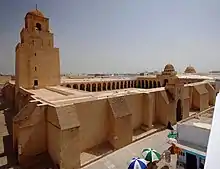
.jpg.webp)
.jpg.webp)
In the 7th century the region of North Africa became steadily integrated into the emerging Muslim world during the Early Arab-Muslim Conquests. The territory of Ifriqiya (roughly present-day Tunisia), and its newly-founded capital city of Kairouan (also transliterated as "Qayrawan") became an early center of Islamic culture for the region.[15] The Great Mosque of Kairouan was founded here by Uqba ibn Nafi in 670.[1][16]
In 711 most of the Iberian Peninsula, part of the Visigothic Kingdom at the time, was conquered by a Muslim (largely Berber) army led by Tariq ibn Ziyad and became known as Al-Andalus. The city of Cordoba became its capital. In 756 Abd ar-Rahman I established the independent Emirate of Cordoba here and in 785 he also founded the Great Mosque of Cordoba, one of the most important architectural monuments of the western Islamic world. The mosque was notable for its vast hypostyle hall composed of rows of columns connected by double tiers of arches (including horseshoe arches on the lower tier) composed of alternating red brick and light-colored stone. The mosque was subsequently expanded by Abd ar-Rahman II in 836, who preserved the original design while extending its dimensions. The mosque was again embellished with new features by his successors Muhammad, Al-Mundhir, and Abdallah. One of the western gates of the mosque, known as Bab al-Wuzara' (today known as Puerta de San Esteban), dates from this period and is often noted as an important prototype of later Moorish architectural forms and motifs.[1][7][5][10]
The Islamization of Morocco, the westernmost territory of the Muslim world, only became more definitive with the advent of the Idrisid dynasty at the end of the 8th century.[15] The Idrisids founded the city of Fes, which became their capital and the major political and cultural center of early Islamic Morocco.[17][18] In this early period Morocco also absorbed waves of immigrants from Tunisia and al-Andalus who brought in cultural and artistic influences from their home countries.[15][3] The earliest well-known Islamic-era monuments in Morocco, such as the Qarawiyyin and Andalusi mosques in Fes, were built in the hypostyle form and made use of the horseshoe arch as well.[1][18] These reflected early influences from other major monuments like the Great Mosque of Kairouan and the Great Mosque of Cordoba.[11]
In the 9th century the province of Ifriqiya, while still nominally under the control of the Abbasid Caliphs in Baghdad, was de facto ruled by the Aghlabid dynasty. The Aghlabids were major builders and erected many of Tunisia's oldest Islamic-era monuments, including military structures like the Ribat of Sousse and the Ribat of Monastir, religious buildings like the Great Mosque of Sousse and the Great Mosque of Sfax, and practical infrastructure works like the Aghlabid Reservoirs of Kairouan. They also rebuilt the Great Mosque of Kairouan, whose present form largely dates from this time. Much of their architecture, even their mosques, had a heavy and almost fortress-like appearance, but they nonetheless left an influential artistic legacy. For example, the Mosque of Ibn Khayrun (also known as the "Mosque of the Three Doors") possesses what is considered by some to be the oldest decorated external façade in Islamic architecture, featuring carved Kufic inscriptions and vegetal motifs.[1][16][10]
The Caliphate of Cordoba and its collapse (10th-11th centuries)
.jpg.webp)
.jpg.webp)
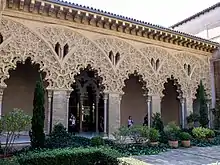
In the 10th century Abd ar-Rahman III declared a new Caliphate in al-Andalus and inaugurated the height of Andalusi power in the region. He marked this political evolution with the creation of a vast and lavish palace-city called Madinat al-Zahra (also spelled and pronounced today as "Medina Azahara"), located just outside Cordoba, whose construction started in 936 and continued for decades.[7] He also expanded the courtyard (sahn) of Cordoba's Great Mosque and built its first true minaret (a tower from which the call to prayer was issued). The minaret, with a square floor plan, set another precedent that was followed in the architecture of other mosques in the region. Abd ar Rahman III's cultured son and successor, al-Hakam II, further expanded the mosque's prayer hall, starting in 962. He endowed it with some of its most significant architectural flourishes and innovations, which included interlacing multifoil arches, decorative ribbed domes, and a richly-ornamented mihrab (niche symbolizing the direction of prayer) with Byzantine-influenced gold mosaics.[1][7] A much smaller but historically notable work from the late caliphate period is the Bab al-Mardum Mosque (later known as the Church of San Cristo de la Luz) in Toledo, which features a variety of ribbed domes resting on horseshoe arches and an exterior façade with Arabic inscriptions carved in brick. Other monuments from the Caliphate period in al-Andalus include several of Toledo's old city gates (e.g. Puerta de Bisagra Antigua), the former mosque (and later monastery) of Almonaster la Real, the Castle of Tarifa, the Castle of Baños de la Encina (near Seville), the Caliphal Baths of Cordoba, and, possibly, the Baths of Jaen.[7]
In the 10th century much of northern Morocco also came directly within the sphere of influence of the Ummayyad Caliphate of Cordoba, with competition from the Fatimid Caliphate further east.[15] Early contributions to Moroccan architecture from this period include expansions to the Qarawiyyin and Andalusi mosques in Fes and the addition of their square-shafted minarets, carried out under the sponsorship of Abd ar-Rahman III and following the example of the minaret he built for the Great Mosque of Cordoba.[18][1]
The collapse of the Cordoban caliphate in the early 11th century gave rise to the first Taifas period, during which al-Andalus was politically fragmented into a number of smaller kingdoms. The disintegration of central authority resulted in the ruin and pillage of Madinat al-Zahra.[19] Despite this political decline, the culture of the Taifa emirates was vibrant and productive, with the architectural forms of the Caliphate period continuing to evolve. The Aljaferia Palace of Zaragoza is one of the most significant examples of this period, containing intricate carved stucco decoration and highly ornate arches which elaborated on the model of the intersecting arches of al-Hakam II's extension in the Mosque of Cordoba. In other cities, a number of important palaces or fortresses were begun or expanded by local dynasties such as the Alcazaba of Malaga. The Alcazar of Seville and the Alcazaba of the Alhambra were also the site of earlier fortresses or palaces by the Abbadids (in Seville) and the Zirids (in Granada), respectively. The Bañuelo of Granada, another historic Islamic bathhouse, also dates from this period.[7][5][1]
The Berber Empires: Almoravids and Almohads (11th-13th centuries)
.jpg.webp)
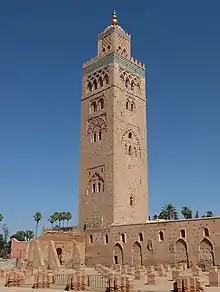
The late 11th century saw the significant advance of Christian kingdoms into Muslim al-Andalus, particularly with the fall of Toledo to Alfonso VI of Castile in 1085, and the rise of major Berber empires originating in Morocco. The latter included first the Almoravids (11th-12th centuries) and then the Almohads (12th-13th centuries), both of whom created empires that stretched across large parts of western and northern Africa and took over the remaining Muslim territories of al-Andalus in Europe.[11] This period is considered one of the most formative stages of Moorish architecture and especially of Moroccan architecture, establishing many of the forms and motifs that were refined in subsequent centuries.[1][20][11][21] The two empires were responsible for establishing a new imperial capital at Marrakesh in Morocco and the Almohads also began construction of a monumental capital in Rabat. The Almoravids adopted the architectural developments of al-Andalus, such as the complex interlacing arches of the Great Mosque in Cordoba and of the Aljaferia palace in Zaragoza, while also introducing new ornamental techniques from the east such as muqarnas ("stalactite" or "honeycomb" carvings).[20][22] Stucco-carved decoration, which would become much more elaborate in subsequent periods, began to appear more and more as part of these compositions.[7]:155 The Almohad Kutubiyya and Tinmal mosques are often considered the prototypes of medieval mosque architecture in the region.[20][1] The monumental minarets of the Kutubiyya Mosque, the Giralda of the Great Mosque of Seville (now part of the city's cathedral), and the Hassan Tower of Rabat, as well as the ornamental gateways of Bab Agnaou in Marrakesh and Bab Oudaia and Bab er-Rouah in Rabat, were all models that established the overall decorative schemes that became recurrent in these architectural elements from then on. The minaret of the Kasbah Mosque of Marrakech was particularly influential and set a style that was repeated, with minor elaborations, in the following Marinid period of Morocco.[23][20][1]
The Almoravids and Almohads also constructed significant monuments in their eastern territories in present-day Algeria or Tunisia. The Great Mosque of Algiers (1096–1097), the Great Mosque of Tlemcen (1136), and the Great Mosque of Nedroma (1145) were all founded in the Almoravid period.[1] The Almohads also made Tunis the regional capital of their territories in Ifriqiya (present-day Tunisia), establishing the city's kasbah (citadel).[24][16]
Marinids, Nasrids, and Zayyanids (13th-15th centuries)
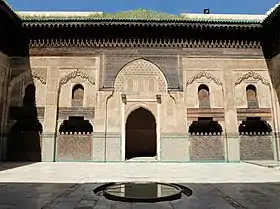
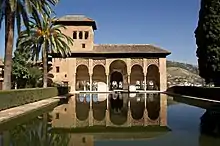
.jpg.webp)
The eventual collapse of the Almohad Empire in the 13th century was precipitated by its defeat at the Battle of Las Navas de Tolosa (1212) in al-Andalus and by the advance of the Berber Marinid dynasty in Morocco. The latter finally conquered Marrakesh in 1269.[15] What remained of the Muslim-controlled territories in al-Andalus was consolidated by the Nasrid dynasty into the Emirate of Granada, which lasted another 250 years until its final conquest by the Catholic Monarchs in 1492, at the end of the Reconquista. Both the Nasrids in al-Andalus to the north and the Marinids in Morocco to the south were important in further refining the artistic legacy established by their predecessors.[1][10] When Granada was conquered in 1492 by Catholic Spain and the last Muslim realm of al-Andalus came to an end, many of the remaining Spanish Muslims (and Jews) fled to Morocco and other parts of North Africa, further increasing the Andalusian influence in these regions in subsequent generations.[4]
The Marinids, who chose Fes as their capital, built monuments with increasingly extensive and intricate decoration on every surface, particularly in wood and stucco.[1] They were also the first to deploy extensive use of zellij (mosaic tilework in complex geometric patterns) in North Africa.[2] Notably, they were also the first to build madrasas in this region, a type of institution which originated in Iran and had spread west.[1] The madrasas of Fes, such as the Bou Inania, al-Attarine, and as-Sahrij madrasas, as well as the Marinid madrasa of Salé and the other Bou Inania in Meknes, are considered among the greatest architectural works of this period.[25][4][1] The Marinids also imitated previous dynasties by founding their own fortified palace-city to the west of Fes, known afterwards as Fes el-Jdid ("New Fez"), which remained a frequent center of power in Morocco even during later dynasties such as the Alaouites.[18][26] The Great Mosque of Fes el-Jdid is one of the major Marinid mosques that is still well-preserved today, though numerous other mosques were built throughout Fes and in other cities during this period (e.g. the Lalla az-Zhar Mosque in Fes, the Ben Salah Mosque in Marrakesh, the Zawiya an-Nussak in Salé, the Great Mosque of Oujda, etc).[1]
The architectural style under the Nasrid dynasty in Granada was very closely related to that of the Marinids and the two kingdoms likely influenced each other's artistic styles.[1][10] The architecture of Nasrid Granada likewise embraced extensive surface decoration and made use of elaborate muqarnas sculpting in many buildings. The Nasrids' most famous architectural legacy is the Alhambra, a hilltop palace district protected by heavy fortifications and containing some of the most famous and best-preserved palaces of western Islamic architecture. Initially a fortress built by the Zirids in the 11th century (corresponding to the current Alcazaba), it was expanded into a self-contained and well-fortified palace district complete with habitations for servants and workers. The oldest remaining palace there today, built under Muhammad III (ruled 1302–1309), is the Palacio del Partal which, although only partly preserved, demonstrates the typical layout which would be repeated in other palaces nearby: a courtyard centered on a large reflective pool with porticoes at either end and a mirador (lookout) tower at one end which looked down on the city from the edge of the palace walls.[27][5][7] The most famous palaces, the Comares Palace and the Courtyard of the Lions, were added afterwards. The Comares Palace, which includes a lavish bathhouse (hammam), was begun under Isma'il I (ruled 1314–1325) but mostly constructed under Yusuf I (1333–1354) and Muhammad V (ruled 1354–1359 and 1362–1391).[5][10] The Courtyard of the Lions (or Palace of the Lions) was built under Muhammad V[10] and possibly finished around 1380.[5]:142 Four other nearby palaces were demolished at various points after the end of the Reconquista (1492).[5] The summer palace and gardens known as the Generalife were also created nearby – at the end of the 13th century[10]:164 or in the early 14th century,[7]:204 – in a tradition reminiscent of the Almohad-era Agdal Gardens of Marrakesh and the Marinid Royal Gardens of Fes.[26] The Nasrids also built other structures throughout the city – such as the Madrasa and the Corral del Carbón – and left their mark on other structures and fortifications throughout their territory, though not many significant structures have survived intact to the present-day.[7]
.JPG.webp)
Meanwhile, in the former territories of al-Andalus under the control of the Spanish kingdoms of Léon, Castile and Aragon, Andalusi art and architecture continued to be employed for many years as a prestigious style under new Christian patrons, becoming what is known as Mudéjar art (named after the Mudéjars or Muslims under Christian rule). This type of architecture, created by Muslim craftsmen or by other craftsmen following the same tradition, continued many of the same forms and motifs with minor variations. Numerous examples are found in the early churches of Toledo (e.g. the Church of San Román, 13th century), as well as other cities in Aragon such as Zaragoza and Teruel.[1][28] Among the most famous and celebrated examples is the Alcazar of Seville, which was the former palace of the Abbadids and the Almohads in the city but was rebuilt in by Christian rulers, including Peter the Cruel who added lavish sections in Moorish style starting in 1364 with the help of craftsmen from Granada and Toledo.[10] Other smaller but notable examples in Cordoba include the Chapel of San Bartolomé[29] and the Royal Chapel (Capilla Real) in the Great Mosque (which was converted to a cathedral in 1236).[30][1] Some surviving 13th and 14th-century Jewish synagogues were also built (or rebuilt) in Mudéjar Moorish style while under Christian rule, such as the Synagogue of Santa Maria la Blanca in Toledo (rebuilt in its current form in 1250),[31]Synagogue of Cordoba (1315),[32] and the Synagogue of El Tránsito (1355-1357).[33][34]
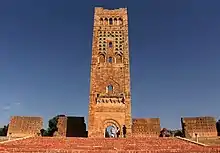
Further east, in Algeria, the Berber Zayyanid or Abd al-Wadid dynasty controlled much of the area and built monuments in their main base at Tlemcen, such as the 13th-century Mosque of Sidi Bel Hasan. The Marinids, however, intermittently occupied Tlemcen and parts of western Algeria and left their mark on the city as well, most notably the Mosque of Sidi Bu Madyan (1339). During their siege of the city at the beginning of the 14th century they built the nearby fortified settlement of al-Mansurah and founded the monumental Mansurah Mosque (only partly preserved today).[1]
The Hafsids of Tunisia (13th-16th centuries)
.jpg.webp)
In Ifriqiya (Tunisia), the Hafsids, a branch of the Almohad ruling class, declared their independence from the Almohads in 1229 and developed their own state which came to control much of the surrounding region. They were also significant builders, particularly under the reigns of successful leaders like Abu Zakariya (ruled 1229–1249) and Abu Faris (ruled 1394–1434), though not many of their monuments have survived intact to the present-day.[10]:208 While Kairouan remained an important religious center, Tunis was the capital and progressively replaced it as the main city of the region and the main center of architectural patronage. Unlike the architecture further west, Hafsid architecture was built primarily in stone (rather than brick or mudbrick) and appears to have featured much less decoration.[10]:208 In reviewing the history of architecture in the region, scholar Jonathan Bloom remarks that Hafsid architecture seems to have "largely charted a course independent of the developments elsewhere in the Maghrib [North Africa]".[10]:213
The Kasbah Mosque of Tunis was one of the first works of this period, built by Abu Zakariya (the first independent Hafsid ruler) at the beginning of his reign. Its floor plan had noticeable differences from previous Almohad-period mosques but the minaret, completed in 1233, bears very strong resemblance the minaret of the earlier Almohad Kasbah Mosque in Marrakesh.[10] Other foundations from the Hafsid period in Tunis include the Haliq Mosque (13th century) and the al-Hawa Mosque (1375). The Bardo Palace (today a national museum) was also begun by the Hafsids in the 15th century,[24] and is mentioned in historical records for the first time during the reign of Abu Faris.[10]:208 The Hafsids also made significant renovations to the much older Great Mosque of Kairouan – renovating its ceiling, reinforcing its walls, and building or rebuilding two of its entrance gates in 1293 – as well as to the Great Mosque of al-Zaytuna in Tunis.[10]:209
The Hafsids also introduced the first madrasas to the region, beginning with the Madrasa al-Shamma῾iyya built in Tunis in 1238[16][10]:209 (or in 1249 according to some sources[1]:296[35]). This was followed by many others (almost all of them in Tunis) such as the Madrasa al-Hawa founded in the 1250s, the Madrasa al-Ma'ridiya (1282), and the Madrasa al-Unqiya (1341).[10] Many of these early madrasas, however, have been poorly preserved or have been considerably modified in the centuries since their foundation.[10][36] The Madrasa al-Muntasiriya, completed in 1437, is among the best preserved madrasas of the Hafsid period.[10]:211
The Hafsids were eventually supplanted by the Ottomans who took over most of the Maghreb in the 16th century, with the exception of Morocco, which remained an independent kingdom.[15] This resulted in an even greater divergence between the architecture of Morocco to the west, which continued to follow essentially the same Andalusi-Maghrebi traditions of art as before, and the architecture of Algeria and Tunisia to the east, which increasingly blended influences from Ottoman architecture into local designs.[10]
The Sharifian dynasties in Morocco: Saadians and Alaouites (16th-20th centuries)
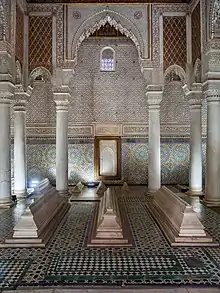
In Morocco, after the Marinids came the Saadian dynasty in the 16th century, which marked a political shift from Berber-led empires to sultanates led by Arab sharifian dynasties. Artistically and architecturally, however, there was broad continuity and the Saadians are seen by modern scholars as continuing to refine the existing Moorish-Moroccan style, with some considering the Saadian Tombs in Marrakesh as one of the apogees of this style.[37] Starting with the Saadians, and continuing with the Alaouites (their successors and the reigning monarchy of Morocco today), Moroccan art and architecture is portrayed by modern scholars as having remained essentially "conservative"; meaning that it continued to reproduce the existing style with high fidelity but did not introduce major new innovations.[1][23][37][2]
The Saadians, especially under the sultans Abdallah al-Ghalib and Ahmad al-Mansur, were extensive builders and benefitted from great economic resources at the height of their power in the late 16th century. In addition to the Saadian Tombs, they also built several major mosques in Marrakesh including the Mouassine Mosque and the Bab Doukkala Mosque, which are notable for being part of larger multi-purpose charitable complexes including several other structures like public fountains, hammams, madrasas, and libraries. This marked a shift from the previous patterns of architectural patronage and may have been influenced by the tradition of building such complexes in Mamluk architecture in Egypt and the külliyes of Ottoman architecture.[23][37] The Saadians also rebuilt the royal palace complex in the Kasbah of Marrakesh for themselves, where Ahmad al-Mansur constructed the famous El Badi Palace (built between 1578 and 1593) which was known for its superlative decoration and costly building materials including Italian marble.[23][37]
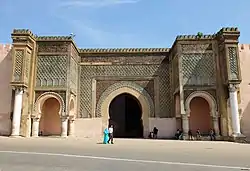
The Alaouites, starting with Moulay Rashid in the mid-17th century, succeeded the Saadians as rulers of Morocco and continue to be the reigning monarchy of the country to this day. As a result, many of the mosques and palaces standing in Morocco today have been built or restored by the Alaouites at some point or another in recent centuries.[4][23][18] Ornate architectural elements from Saadian buildings, most infamously from the lavish El Badi Palace, were also stripped and reused in buildings elsewhere during the reign of Moulay Isma'il (1672–1727).[37] Moulay Isma'il is also notable for having built a vast imperial capital in Meknes, where the remains of his monumental structures can still be seen today. In 1765 Sultan Mohammed Ben Abdallah (one of Moulay Isma'il's sons) started the construction of a new port city called Essaouira (formerly Mogador), located along the Atlantic coast as close as possible to his capital at Marrakesh, to which he tried to move and restrict European trade.[15]:241[10]:264 He hired European architects to design the city, resulting in a relatively unique historic city built by Moroccans but with Western European architecture, particularly in the style of its fortifications. Similar maritime fortifications or bastions, usually called a sqala, were built at the same time in other port cities like Anfa (present-day Casablanca), Rabat, Larache, and Tangier.[1]:409 Late sultans were also significant builders. Up until the late 19th century and early 20th century, both the sultans and their ministers continued to build beautiful palaces, many of which are now used as museums or tourist attractions, such as the Bahia Palace in Marrakesh, the Dar Jamaï in Meknes, and the Dar Batha in Fes.[2][38]
Architectural features
Characteristic elements of Moorish architecture include horseshoe or "Moorish" arches, interlacing arches, central courtyards, riad gardens, intricately carved wood and stucco as decoration, muqarnas sculpting, and decorative tile work known as zellij in Arabic or azulejo in Spanish and Portuguese.[1] The architectural tradition is exemplified by mosques, madrasas, palaces, fortifications, hammams (bathhouses), funduqs (caravanserais), and other historic building types common to the Islamic world.[1] Notable examples include the Mezquita in Córdoba (784–987, in four phases); the ruined palace-city of Medina Azahara (936–1010); the church (former mosque) San Cristo de la Luz in Toledo; the Aljafería in Zaragoza; the Alhambra (mainly 1338–1390[39]) and Generalife (1302–9 and 1313–24) in Granada; the Giralda in Seville (1184);[40] the Kutubiyya Mosque, Hassan Mosque, Andalusian Mosque, and al-Qarawiyyin Mosque in Morocco; the Great Mosque of Algiers and the Great Mosque of Tlemcen in Algeria; and the Mosque of Uqba in Kairouan, Tunisia.[1]
The term is sometimes used to include the products of the Islamic civilisation of Southern Italy.[41] The Palazzo dei Normanni in Sicily was begun in the 9th century by the Emir of Palermo. There is even archaeological evidence of an eighth-century mosque in Narbonne, France, at the limits of Muslim expansion in the region in the 8th century.[42]
Horseshoe arch
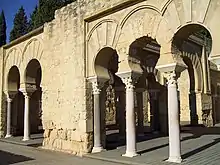

Perhaps the most characteristic arch type of western Islamic architecture generally is the so-called "Moorish" or "horseshoe" arch. This is an arch where the curves of the arch continue downward past the horizontal middle axis of the circle and begin to curve towards each other, rather than just forming a half circle.[2]:15 This arch profile became nearly ubiquitous in the region from the very beginning of the Islamic period.[1]:45 The origin of this arch appear to date back to the preceding Byzantine period across the Mediterranean, as versions of it appear in Byzantine-era buildings in Cappadocia, Armenia, and Syria. They also appear frequently in Visigothic churches in the Iberian peninsula (5th-7th centuries). Perhaps due to this Visigothic influence, horseshoe arches were particularly predominant afterwards in al-Andalus under the Umayyads of Cordoba, although the "Moorish" arch was of a slightly different and more sophisticated form than the Visigothic arch.[1]:163–164[7]:43 Arches were not only used for supporting the weight of the structure above them. Blind arches and arched niches were also used as decorative elements. The mihrab (niche symbolizing the qibla) of a mosque was almost invariably in the shape of horseshoe arch.[1]:164[2]
Starting in the Almoravid period, the first pointed or "broken" horseshoe arches began to appear in the region and became more widespread during the Almohad period. This arch is likely of North African origin, since pointed arches were already present in earlier Fatimid architecture further east.[1]:234
Polylobed arch
Polylobed (or multifoil) arches, have their earliest precedents in Fatimid architecture in Ifriqiya and Egypt and had also appeared in Andalusi Taifa architecture such as the Aljaferia palace and the Alcazaba of Malaga, which elaborated on the existing examples of al-Hakam II's extension to the Great Mosque of Cordoba. In the Almoravid and Almohad periods, this type of arch was further refined for decorative functions while horseshoe arches continued to be standard elsewhere.[1]:232–234 Some early examples appear in the Great Mosque of Tlemcen (in Algeria) and the Mosque of Tinmal.[1]:232
 Interlacing polylobed arches at the Alcazaba of Malaga in Spain (11th century)
Interlacing polylobed arches at the Alcazaba of Malaga in Spain (11th century)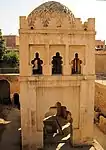
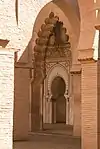 A polylobed arch in the Mosque of Tinmal in Morocco (mid-12th century)
A polylobed arch in the Mosque of Tinmal in Morocco (mid-12th century) Polylobed arches in the Mudéjar-style Patio de las Doncellas at the Alcazar of Seville in Spain (14th century)
Polylobed arches in the Mudéjar-style Patio de las Doncellas at the Alcazar of Seville in Spain (14th century)
"Lambrequin" arch
The so-called "lambrequin" arch,[1][2] with a more intricate profile of lobes and points, was also introduced in the Almoravid period, with an early appearance in the funerary section of the Qarawiyyin Mosque (in Fes) dating from the early 12th century.[1]:232 It then became common in subsequent Almohad, Marinid, and Nasrid architecture, in many cases used to highlight the arches near the mihrab area of a mosque.[1] This type of arch is also sometimes referred to as a "muqarnas" arch due to its similarities with a muqarnas profile and because of its speculated derivation from the use of muqarnas itself.[1]:232 Moreover, this type of arch was indeed commonly used with muqarnas sculpting along the intrados (inner surfaces) of the arch.[1][43][2]
 Lambrequin arches in the Mosque of Tinmal (mid-12th century)
Lambrequin arches in the Mosque of Tinmal (mid-12th century).jpg.webp) A lambrequin or "muqarnas" arch with muqarnas decoration in the Madrasa al-Attarine, Fes (1323-1325)
A lambrequin or "muqarnas" arch with muqarnas decoration in the Madrasa al-Attarine, Fes (1323-1325).jpg.webp) A lambrequin/muqarnas arch (top) in the gallery of the Courtyard of the Lions in the Alhambra, Granada (14th century)
A lambrequin/muqarnas arch (top) in the gallery of the Courtyard of the Lions in the Alhambra, Granada (14th century).jpg.webp) Lambrequin arches in the Bahia Palace in Marrakesh, Morocco (late 19th century)
Lambrequin arches in the Bahia Palace in Marrakesh, Morocco (late 19th century)
Floral and vegetal motifs
Arabesques, or floral and vegetal motifs, derive from a long tradition of similar motifs in Syrian, Hellenistic, and Roman architectural ornamentation.[1][2] Early arabesque motifs in Umayyad Cordoba, such as those seen at the Great Mosque or Madinat al-Zahra, continued to make use of acanthus leaves and grapevine motifs from this Hellenistic tradition. Almoravid and Almohad architecture made more use of a general striated leaf motif, often curling and splitting into unequal parts along an axis of symmetry.[1][2] Palmettes and, to a lesser extent, seashell and pine cone images were also featured.[1][2] In the late 16th century, Saadian architecture sometimes made use of a mandorla-type (or almond-shaped) motif which may have been of Ottoman influence.[37]:128
.jpg.webp)
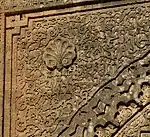
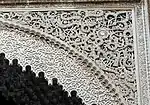 Arabesques carved in stucco over an archway in the al-Attarine Madrasa in Fes (14th century)
Arabesques carved in stucco over an archway in the al-Attarine Madrasa in Fes (14th century)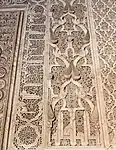
"Interlacing" motif (sebka and darj wa ktaf)
Various types of interlacing lozenge-like motifs are heavily featured on the surface of minarets starting in the Almohad period (12th-13th centuries) and are later found in other decoration such as carved stucco along walls in Marinid and Nasrid architecture, eventually becoming a standard feature in the western Islamic ornamental repertoire in combination with arabesques.[2][1] This motif, typically called sebka (meaning "net"),[5]:80[44] is believed by some scholars to have originated with the large interlacing arches in the 10th-century extension of the Great Mosque of Cordoba by Caliph al-Hakam II.[1]:257–258 It was then miniaturized and widened into a repeating net-like pattern that can cover surfaces. This motif, in turn, had many detailed variations. One common version, called darj wa ktaf ("step and shoulder") by Moroccan craftsmen, makes use of alternating straight and curved lines which cross each other on their symmetrical axes, forming a motif that looks roughly like a fleur-de-lys or palmette shape.[1]:232[2]:32 Another version, also commonly found on minarets in alternation with the darj wa ktaf, consists of interlacing multifoil/polylobed arches which form a repeating partial trefoil shape.[2]:32, 34
.jpg.webp) A sebka or darj wa ktaf motif on one of the facades of the Hassan Tower in Rabat, Morocco (late 12th century)
A sebka or darj wa ktaf motif on one of the facades of the Hassan Tower in Rabat, Morocco (late 12th century) Variation of the sebka motif with a trefoil-like shape on the minaret of the Kasbah Mosque in Marrakesh, Morocco (late 12th century)
Variation of the sebka motif with a trefoil-like shape on the minaret of the Kasbah Mosque in Marrakesh, Morocco (late 12th century)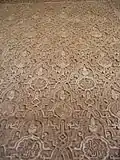
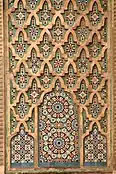 Darj wa ktaf motif on Bab Mansour in Meknes, Morocco (early 18th century)
Darj wa ktaf motif on Bab Mansour in Meknes, Morocco (early 18th century)
Geometric patterns
Geometric patterns, most typically making use of intersecting straight lines which are rotated to form a radiating star-like pattern, were common in Islamic architecture generally and across Moorish architecture. These are found in carved stucco and wood decoration, and most notably in zellij mosaic tilework which became commonplace in Moorish architecture from the Marinid and Nasrid period onward. Other polygon motifs are also found, often in combination with arabesques.[1][2] In addition to zellij tiles, geometric motifs were also predominant in the decoration and composition of wooden ceilings. One of the most famous examples of such ceilings, considered the masterpiece of its kind, is the ceiling of the Salón de Embajadores in the Comares Palace at the Alhambra in Granada, Spain. The ceiling, composed of 8,017 individual wooden pieces joined together into a pyramid-like dome, consists of a recurring 16-pointed star motif which is believed to have symbolized the seven heavens of Paradise described in the Qur'an (specifically the Surat al-Mulk, which is also inscribed at the ceiling's base).[10]:159 Like other stucco and wood decoration, it would have originally been painted in different colours order to enhance its motifs.[45]:44
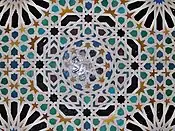
.jpg.webp)
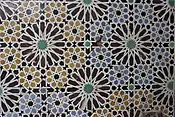 Twelve-pointed star motifs in zellij tilework at the Saadian Tombs in Marrakesh, Morocco (16th century)
Twelve-pointed star motifs in zellij tilework at the Saadian Tombs in Marrakesh, Morocco (16th century).jpg.webp) Geometric motifs on the bronze plating of the doors of the Al-Attarine Madrasa (14th century)
Geometric motifs on the bronze plating of the doors of the Al-Attarine Madrasa (14th century)%252C_Granada.jpg.webp) The enormous wooden ceiling of the Salón de Embajadores (the Nasrid throne room) at the Alhambra in Granada, Spain (14th century)
The enormous wooden ceiling of the Salón de Embajadores (the Nasrid throne room) at the Alhambra in Granada, Spain (14th century)_(cropped).jpg.webp) Another example of geometric patterns in a (smaller and simpler) wooden ceiling in the Ben Youssef Madrasa in Marrakesh (16th century)
Another example of geometric patterns in a (smaller and simpler) wooden ceiling in the Ben Youssef Madrasa in Marrakesh (16th century).jpg.webp) Painted geometric motifs on a wooden ceiling in the Bahia Palace in Marrakesh (late 19th century)
Painted geometric motifs on a wooden ceiling in the Bahia Palace in Marrakesh (late 19th century)
Arabic calligraphy
Many Islamic monuments feature inscriptions of one kind or another which serve to either decorate or inform, or both. Arabic calligraphy, as in other parts of the Muslim world, was also an art form. Many buildings had foundation inscriptions which record the date of their construction and the patron who sponsored it. Inscriptions could also feature Qur'anic verses, exhortations of God, and other religiously significant passages. Early inscriptions were generally written in the Kufic script, a style where letters were written with straight lines and had fewer flourishes.[1][2]:38 At a slightly later period, mainly in the 11th century, Kufic letters were enhanced with ornamentation, particularly to fill the empty spaces that were usually present above the letters. This resulted in the addition of floral forms or arabesque backgrounds to calligraphic compositions.[1]:251 In the 12th century a "cursive" script began to appear, though it only became commonplace in monuments from the Marinid and Nasrid period (13th-15th century) onward.[1]:250, 351–352[2]:38 Kufic was still employed, especially for more formal or solemn inscriptions such as religious content.[2]:38[1]:250, 351–352 By contrast, however, Kufic script could also be used in a more strictly decorative form, as the starting point for an interlacing motif that was could be woven into a larger arabesque background.[1]:351–352
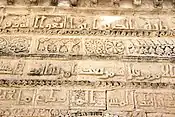 Kufic inscriptions carved into the façade of the Mosque of the Three Doors in Kairouan, Tunisia, dating from 866
Kufic inscriptions carved into the façade of the Mosque of the Three Doors in Kairouan, Tunisia, dating from 866_(29800019186).jpg.webp) Kufic Arabic inscriptions in gold mosaics above the mihrab of the Great Mosque of Cordoba (10th century)
Kufic Arabic inscriptions in gold mosaics above the mihrab of the Great Mosque of Cordoba (10th century) Late 12th-century Kufic inscription carved into stone on the Almohad gate of Bab Agnaou in Marrakesh
Late 12th-century Kufic inscription carved into stone on the Almohad gate of Bab Agnaou in Marrakesh.jpg.webp) Kufic script with floral and interlacing flourishes, painted on tile, in the Al-Attarine Madrasa, Fes, Morocco (early 14th century)
Kufic script with floral and interlacing flourishes, painted on tile, in the Al-Attarine Madrasa, Fes, Morocco (early 14th century).jpg.webp) Arabic calligraphic inscription in cursive script carved into stucco in the al-Attarine Madrasa in Fes (early 14th century)
Arabic calligraphic inscription in cursive script carved into stucco in the al-Attarine Madrasa in Fes (early 14th century).jpg.webp) Arabic calligraphic inscription carved into wood in the Sahrij Madrasa in Fes, surrounded by other arabesque decoration (early 14th century)
Arabic calligraphic inscription carved into wood in the Sahrij Madrasa in Fes, surrounded by other arabesque decoration (early 14th century).jpg.webp) The Nasrid motto ("There is no conqueror but God") in cursive Arabic calligraphy the Salón de Embajadores in the Alhambra, Granada (14th century)
The Nasrid motto ("There is no conqueror but God") in cursive Arabic calligraphy the Salón de Embajadores in the Alhambra, Granada (14th century)
Muqarnas
Muqarnas (also called mocárabe in Spain), sometimes referred to as "honeycomb" or "stalactite" carvings, consists of a three-dimensional geometric prismatic motif which is among the most characteristic features of Islamic architecture. This technique originated further east in Iran before spreading across the Muslim world.[1]:237 It was first introduced into al-Andalus and the western Maghreb by the Almoravids, who made early use of it in early 12th century in the Qubba Ba'adiyyin in Marrakesh and in the Qarawiyyin Mosque in Fes.[20][22][1]:237 While the earliest forms of muqarnas in Islamic architecture were used as squinches or pendentives at the corners of domes,[1]:237 they were quickly adapted to other architectural uses. In the western Islamic world they were particularly dynamic and were used, among other examples, to enhance entire vaulted ceilings, fill in certain vertical transitions between different architectural elements, and even to highlight the presence of windows on otherwise flat surfaces.[1][4][2]
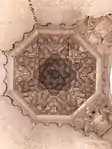 Small muqarnas cupola inside the mihrab of the Mosque of Tinmal (mid-12th century)
Small muqarnas cupola inside the mihrab of the Mosque of Tinmal (mid-12th century)
.jpg.webp)
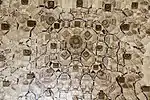 Closer view of the details at the apex of a muqarnas dome in the Sala de los Reyes in the Alhambra
Closer view of the details at the apex of a muqarnas dome in the Sala de los Reyes in the Alhambra.jpg.webp) Extreme close-up of carved and painted details in constituent niches of a muqarnas dome in the Sala de los Reyes in the Alhambra
Extreme close-up of carved and painted details in constituent niches of a muqarnas dome in the Sala de los Reyes in the Alhambra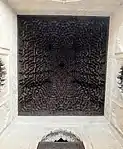 Rectangular muqarnas vault carved in cedar wood at the Bou Inania Madrasa in Fes, Morocco (mid-14th century)
Rectangular muqarnas vault carved in cedar wood at the Bou Inania Madrasa in Fes, Morocco (mid-14th century)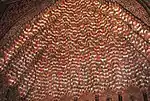 Muqarnas carved in wood in the Dar al-Makhzen of Tangier (17th century or later)
Muqarnas carved in wood in the Dar al-Makhzen of Tangier (17th century or later)
Zellij (tilework)
Tilework, particularly in the form of mosaic tilework called zellij (also called azulejos in Spain and Portugal), is a standard decorative element along lower walls and for the paving of floors across the region. It consists of hand-cut pieces of faience in different colours fitted together to form elaborate geometric motifs, often based on radiating star patterns.[4][1] Zellij made its appearance in the region during the 10th century and became widespread by the 14th century during the Marinid and Nasrid period.[4] It may have been inspired or derived from Byzantine mosaics and then adapted by Muslim craftsmen for faience tiles.[4]
In the traditional Moroccan craft of zellij-making, the tiles are first fabricated in glazed squares, typically 10 cm per side, then cut by hand into a variety of pre-established shapes (usually memorized by heart) necessary to form the overall pattern.[2] This pre-established repertoire of shapes combined to generate a variety of complex patterns is also known as the hasba method.[47] Although the exact patterns vary from case to case, the underlying principles have been constant for centuries and Moroccan craftsmen are still adept at making them today.[2][47]
Riads and gardens
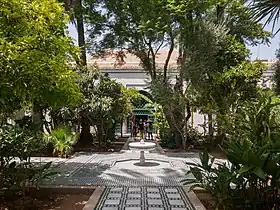
A riad (sometimes spelled riyad; Arabic: رياض) is an interior garden found in many Moorish palaces and mansions. It is typically rectangular and divided into four parts along its central axes, with a fountain at its middle.[48] Riad gardens probably originated in Persian architecture (where it is also known as chahar bagh) and became a prominent feature in Moorish palaces in Spain (such Madinat al-Zahra, the Aljaferia, and the Alhambra).[48] In Morocco, they became especially widespread in the palaces and mansions of Marrakesh, where the combination of available space and warm climate made them particularly appealing.[48] The term is nowadays applied in a broader way to traditional Moroccan houses that have been converted into hotels and tourist guesthouses.[49][50]
Many royal palaces were also accompanied by vast pleasure gardens, sometimes built outside the main defensive walls or within their own defensive enclosure. This tradition is evident in the gardens of the Madinat al-Zahra built by the Caliphs of Cordoba (10th century), in the Agdal Gardens south of the Kasbah of Marrakesh created by the Almohads (12th century), the Mosara Garden created by the Marinids north of their palace-city of Fes el-Jdid (13th century), and the Generalife created by the Nasrids east of the Alhambra (13th century).[1][23][26]
Building types
Mosques
_(2).jpg.webp)
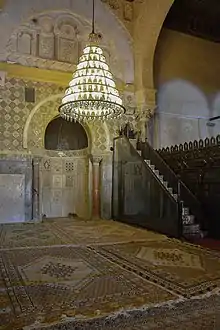

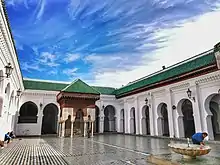
Mosques are the main place of worship in Islam. Muslims are called to prayer five times a day and participate in prayers together as a community, facing towards the qibla (direction of prayer). Every neighbourhood normally had one or many mosques in order to accommodate the spiritual needs of its residents. Historically, there was a distinction between regular mosques and "Friday mosques" or "great mosques", which were larger and had a more important status by virtue of being the venue where the khutba (sermon) was delivered on Fridays.[18] Friday noon prayers were considered more important and were accompanied by preaching, and also had political and social importance as occasions where news and royal decrees were announced, as well as when the current ruler's name was mentioned. In the early Islamic era there was typically only one Friday mosque per city, but over time Friday mosques multiplied until it was common practice to have one in every neighbourhood or district of the city.[51][43] Mosques could also frequently be accompanied by other facilities which served the community.[43][23]
Mosque architecture in Al-Andalus and the Maghreb was heavily influenced from the beginning by major well-known mosques in early cultural centers like the Great Mosque of Kairouan and the Great Mosque of Cordoba.[1][10][11] Accordingly, most mosques in the region have roughly rectangular floor plans and follow the hypostyle format: they consist of a large prayer hall upheld and divided by rows of horseshoe arches running either parallel or perpendicular to the qibla wall (the wall towards which prayers faced). The qibla (direction of prayer) was always symbolized by a decorative niche or alcove in the qibla wall, known as a mihrab.[2] Next to the mihrab there was usually a symbolic pulpit known as a minbar, usually in the form of a staircase leading to a small kiosk or platform, where the imam would stand to deliver the khutba. The mosque also normally included, close to entrance, a sahn (courtyard) which often had fountains or water basins to assist with ablutions. In early periods this courtyard was relatively minor in proportion to the rest of the mosque, but in later periods it became a progressively larger until it was equal in size to the prayer hall and sometimes larger.[37][43] Medieval hypostyle mosques also frequently followed the "T-type" model established in the Almohad period. In this model the aisle or "nave" between the arches running towards the mihrab (and perpendicular to the qibla wall) was wider than the others, as was also the aisle directly in front of and along the qibla wall (running parallel to the qibla wall); thus forming a "T"-shaped space in the floor plan of the mosque which was often accentuated by greater decoration (e.g. more elaborate arch shapes around it or decorative cupola ceilings at each end of the "T").[43][37][23]
Lastly, mosque buildings were distinguished by their minarets: towers from which the muezzin issues the call to prayer to the surrounding city. (This was historically done by the muezzin climbing to the top and projecting his voice over the rooftops, but nowadays the call is issued over modern megaphones installed on the tower.) Minarets traditionally have a square shaft and are arranged in two tiers: the main shaft, which makes up most of its height, and a much smaller secondary tower above this which is in turn topped by a finial of copper or brass spheres.[1][43] Some minarets in North Africa have octagonal shafts, though this is more characteristic of certain regions or periods.[4][16] Inside the main shaft a staircase, and in other cases a ramp, ascends to the top of the minaret.[1][43]
The whole structure of a mosque was also orientated or aligned with the direction of prayer (qibla), such that mosques were sometimes orientated in a different direction from the rest of the buildings or streets around it.[48] This geographic alignment, however, varied greatly from period to period. Nowadays it is standard practice across the Muslim world that the direction of prayer is the direction of the shortest distance between oneself and the Kaaba in Mecca. In Morocco, this corresponds to a generally eastern orientation (varying slightly depending on your exact position).[52] However, in early Islamic periods there were other interpretations of what the qibla should be. In the western Islamic world (the Maghreb and al-Andalus), in particular, early mosques often had a southern orientation, as can be seen in major early mosques like the Great Mosque of Cordoba and the Qarawiyyin Mosque in Fes. This was based on a reported hadith of the Prophet Muhammad which stated that "what is between the east and west is a qibla", as well as on a popular view that mosques should not be aligned towards the Kaaba but rather that they should follow the cardinal orientation of the Kaaba itself (which is a rectangular structure with its own geometric axes), which is in turn aligned according to certain astronomical references (e.g. its minor axis is aligned with the sunrise of the summer solstice).[53][52][48]
Synagogues
.jpg.webp)
Synagogues had a very different layout from mosques but in North Africa and Al-Andalus they often shared similar decorative trends as the traditional Islamic architecture around them, such as colourful tilework and carved stucco,[54][55] though later synagogues in North Africa were built in other styles too. Notable examples of historic synagogues in Spain include the Synagogue of Santa Maria la Blanca in Toledo (rebuilt in its current form in 1250),[31] the Synagogue of Cordoba (1315),[32] and the Synagogue of El Tránsito in Toledo (1355-1357). Morocco include the Ibn Danan Synagogue in Fes, the Slat al-Azama Synagogue in Marrakesh, or the Beth-El Synagogue in Casablanca, though numerous other examples exist.[56][57] One of the most famous historic synagogues in Tunisia is the 19th-century El Ghriba Synagogue.
Madrasas
.jpeg.webp)
The madrasa was an institution which originated in northeastern Iran by the early 11th century and was progressively adopted further west.[1][2] These establishments provided higher education and served to train Islamic scholars, particularly in Islamic law and jurisprudence (fiqh). The madrasa in the Sunni world was generally antithetical to more "heterodox" religious doctrines, including the doctrine espoused by the Almohad dynasty. As such, in the westernmost parts of the Islamic world it only came to flourish in the late 13th century, after the Almohads, starting especially under the Marinid and Hafsid dynasty.[1][10] To dynasties like the Marinids, madrasas also played a part in bolstering the political legitimacy of their rule. They used this patronage to encourage the loyalty of the country's influential but independent religious elites and also to portray themselves to the general population as protectors and promoters of orthodox Sunni Islam.[1][58] Finally, madrasas also played an important role in training the scholars and elites who operated the state bureaucracy.[58] Madrasas also played a supporting role to major learning institutions of the region like the Qarawiyyin Mosque in Fes; in part because, unlike the mosque, they provided accommodations for students who came from outside the city.[2]:137[3]:110 Many of these students were poor, seeking sufficient education to gain a higher position in their home towns, and the madrasas provided them with basic necessities such as lodging and bread.[18]:463 However, the madrasas were also teaching institutions in their own right and offered their own courses, with some Islamic scholars making their reputation by teaching at certain madrasas.[3]:141
Madrasas were generally centered around a main courtyard with a central fountain, off which other rooms could be accessed. Student living quarters were typically distributed on an upper floor around the courtyard. Many madrasas also included a prayer hall with a mihrab, though only the Bou Inania Madrasa of Fes officially functioned as a full mosque and featured its own minaret.[25][1][10]
Mausoleums and zawiyas

Most Muslim graves are traditionally simple and unadorned, but in North Africa the graves of important figures were often covered in a domed structure (or a cupola of often pyramidal shape) called a qubba (also spelled koubba). This was especially characteristic for the tombs of "saints" such as walis and marabouts: individuals who came to be venerated for their strong piety, reputed miracles, or other mystical attributes. Many of these existed within the wider category of Islamic mysticism known as Sufism. Some of these tombs became the focus of entire religious complexes built around them, known as a zawiya (also spelled zaouia; Arabic: زاوية).[23][1][59] They typically included a mosque, school, and other charitable facilities.[1] Such religious establishments were major centers of Sufism across the region and grew in power and influence over the centuries, often associated with specific Sufi Brotherhoods or schools of thought.[23][10][15]
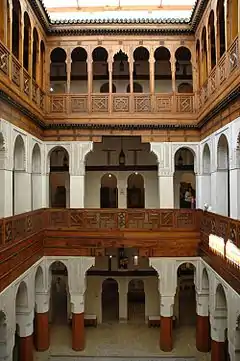
Funduqs (merchant inns)
A funduq (also spelled foundouk or fondouk; Arabic: فندق) was a caravanserai or commercial building which served as both an inn for merchants and a warehouse for their goods and merchandise.[1][2][48] In North Africa some funduqs also housed the workshops of local artisans.[18] As a result of this function, they also became centers for other commercial activities such as auctions and markets.[18] They typically consisted of a large central courtyard surrounded by a gallery, around which storage rooms and sleeping quarters were arranged, frequently over multiple floors. Some were relatively simple and plain, while others, like the Funduq al-Najjarin in Fes, were quite richly decorated.[4] While many structures of this kind can be found in historic North African cities, the only one in Al-Andalus to have been preserved is the Nasrid-era Corral del Carbón in Granada.[60][10]
Hammams (bathhouses)
.jpg.webp)
Hammams (Arabic: حمّام) are public bathhouses which were ubiquitous in Muslim cities. Essentially derived from the Roman bathhouse model, hammams normally consisted of four main chambers: a changing room, from which one then moved on to a cold room, a warm room, and a hot room.[1]:215–216, 315–316[61] Heat and steam were generated by a hypocaust system which heated the floors. The furnace re-used natural organic materials (such as wood shavings, olive pits, or other organic waste byproducts) by burning them for fuel.[62] The smoke generated by this furnace helped with heating the floors while excess smoke was evacuated through chimneys. Of the different rooms, only the changing room was heavily decorated with zellij, stucco, or carved wood.[1]:316 The cold, warm, and hot rooms were usually vaulted or domed chambers without windows, designed to keep steam from escaping, but partially lit thanks to small holes in the ceiling which could be covered by ceramic or coloured glass.[1]:316 Many historic hammams have been preserved in cities like Marrakesh and Fez in Morocco, partly thanks to their continued use by locals up to the present day.[63][61][64] In Al-Andalus, by contrast, they fell out of use after the expulsion of Muslims from the Iberian Peninsula and are only preserved as archeological sites or historic monuments.[65]
In Al-Andalus
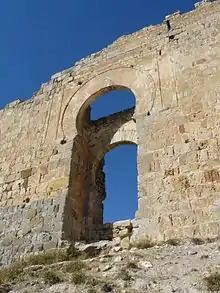

The remains of castles and fortifications from various periods of Al-Andalus have survived across Spain and Portugal, often situated on hilltops and elevated positions that command the surrounding countryside. A large number of Arabic terms were used to denote the different types and functions of these structures, many of which were borrowed into Spanish and are found in numerous toponyms. Some of the most important terms include Alcazaba (from Arabic: القَـصَـبَـة, romanized: al-qaṣabah), meaning a fortified enclosure or citadel where the governor or ruler was typically installed, and Alcázar (from Arabic: القصر, romanized: al-qaṣr), which was typically a palace protected by fortifications.[67][7] Fortifications were built either in stone or in rammed earth. Stone was used more commonly in the Umayyad period while rammed earth became more common in subsequent periods and was also more common in the south.[7][67]
.jpg.webp)
In the Umayyad period (8th-10th centuries) an extensive network of fortifications stretched in a wide line roughly from Lisbon in the west then up through the Central System of mountains in Spain, around the region of Madrid, and finally up to the areas of Navarre and Huesca, north of Zaragoza, in the east.[67]:63 In addition to these border defenses, castles and fortified garrisons existed in the interior regions of the realm as well.[7] Such fortifications were built from the very beginning of Muslim occupation in the 8th century, but a larger number of remaining examples date from the Caliphal period of the 10th century. Some notable examples from this period include the Castle of Gormaz, the Castle of Tarifa, the Alcazaba of Trujillo, the Alcazaba of Guadix, the castle of Baños de la Encina, and the Alcazaba of Mérida.[7][67][68] The castle of El Vacar near Cordoba is an early example of a rammed-earth fortification in Al-Andalus, likely dating from the Emirate period (756-912), while the castle at Baños de la Encina, dating from later in the 10th century, is a more imposing example of rammed earth construction.[69][67] Many of these early fortifications had relatively simple architecture with no barbicans and only a single line of walls. The gates were typically straight entrances with an inner and outer doorway (often in the form of horseshoe arches) on the same axis.[7]:100, 116 The castles typically had quadrangular layouts with walls reinforced by rectangular towers.[67]:67 In order to guarantee a protected access to water even in times of siege, some castles had a tower built on a riverbank which was connected to the main castle via a wall, known in Spanish as a coracha. One of the oldest examples of this can be found at Calatrava la Vieja (9th century), while a much later example is the tower of the Puente del Cadi below the Alhambra in Granada.[67]:71 The Alcazaba of Mérida also features an aljibe (cistern) inside the castle which draws water directly from the nearby river.[70][71] Moats were also used as defensive measures up until the Almohad period.[67]:71–72 In addition to the more sizeable castles, there was a proliferation of smaller castles and forts which held local garrisons, especially from the 10th century onward.[67]:65 Additionally, multitudes of small, usually round, watch towers were built which could rapidly send messages to each other via fire or smoke signals. Using this system of signals, a coded message from Soria in northern Spain, for example, could arrive in Cordoba after as little as five hours. The Watchtower of El Vellón, near Madrid, is one surviving example, along with others in the region. This system continued to be used even up until the time of Philip II in the 16th century.[67]:66
Following the collapse of the Caliphate in the 11th century, the resulting political insecurity encouraged further fortification of cities. The Zirid walls of Granada along the northern edge of the Albaicin today (formerly the Old Alcazaba of the city) date from this time, as do the walls of Niebla, the walls of Jativa, and the walls of Almeria and its Alcazaba.[7]:115 The Alcazaba of Málaga also dates from this period but was later redeveloped under the Nasrids. Traces of an 11th-century fortress also exist on the site of Granada's current Alcazaba in the Alhambra.[7] Military architecture also became steadily more complex, with fortified gates now having bent entrances – meaning that their passage made one or more right-angle turns in order to slow down any attackers.[7]:116

.jpg.webp)
Later on, the Almohads (12th and early 13th centuries) were particularly active in the restoration and construction of fortresses and city walls across the regions under their control in order to counter the growing threat of the Christian Reconquista. The fortress of Alcalá de Guadaíra is a clear example dating from this time, as well as the Paderne Castle in present-day Portugal.[7]:166[68] The walls of Seville and Silves also date from this time, both of them either built, restored, or expanded by the Almoravids and Almohads.[68][73][74][75] Military technology again became more sophisticated, with barbicans appearing in front of city walls and albarrana towers appearing as a recurring innovation.[7]:166 Both Cordoba and Seville were reinforced by the Almohads with a set of double walls in rammed earth, consisting of a main wall with regular bastion towers and a smaller outer wall, both topped by a walkway (chemin de ronde) with battlements.[1]:225 Fortification towers also became taller and more massive, sometimes with round or polygonal bases but more commonly still rectangular. Some of the more famous tower fortifications from this period include the Calahorra Tower in Cordoba, which guarded the outer end of the old Roman bridge, and the Torre del Oro in Seville, a dodecagonal tower which fortified a corner of the city walls and which, along with another tower across the river, protected the city's harbour.[7]:166
In the 13th-15th centuries, during the final period of Muslim rule in Al-Andalus, fortresses and towns were again refortified by either the Nasrids or (in fewer cases) the Marinids. In addition to the fortifications of Granada and its Alhambra, the Nasrids built or rebuilt the Gibralfaro Castle of Málaga and the castle of Antequera, and many smaller strategic hilltop forts like that of Tabernas.[7]:212 A fortified arsenal (dar as-sina'a) was also built in Malaga, which served as a Nasrid naval base.[1]:323 This late period saw the construction of massive towers and keeps which likely reflected a growing influence of Christian military architecture. The Calahorra Tower (now known as the Torre de Homenaje) of the Moorish castle in Gibraltar is one particular example of this, built by the Marinids in the 14th century.[7]:212[1]:322
In the Maghreb

Some of the oldest surviving Islamic-era monuments in the Maghreb are military structures in Ifriqiya and present-day Tunisia. The best-known examples are the Ribat of Sousse and the Ribat of Monastir, both dating generally from the Aghlabid period in the 9th century. A ribat was a type of residential fortress which was built to guard the early frontiers of Muslim territory in North Africa, including the coastline. They were built at intervals along the coastline so that they could signal each other from afar. Especially in later periods, ribats also served as a kind of spiritual retreat, and the examples in Sousse and Monastir both contained prayer rooms that acted as mosques. Also dating from the same period are the city walls of Sousse and Sfax, both made in stone and bearing similarities to earlier Byzantine-Roman walls in Africa.[1]:29–36[10]:25–27
After the Aghlabids came the Fatimids, who took over Ifriqiya in the early 10th century. Most notably, the Fatimids built a heavily-fortified new capital at Mahdia, located on a narrow peninsula extending from the coastline into the sea. The narrow land approach to the peninsula was protected by an extremely thick stone wall reinforced with square bastions and a round polygonal tower at either end where the wall met the sea. The only gate was the Skifa al-Kahla (Arabic: السقيفة الكحلة, romanized: al-saqifa al-kaḥla, lit. 'the dark vestibule'), defended by two flanking bastions and featuring a vaulted interior passage 44 meters long. (Although it's not clear today how much of the structure dates from the original Fatimid construction.) The peninsula's shoreline was also defended by a stone wall with towers at regular intervals, interrupted only by the entrance to a man-made harbor and arsenal.[1]:89–91[10]:47
The Hammadids, who started out as governors as governors of the Zirids (who were in turn governors for the Fatimids), also built a new fortified capital in Algeria known as Qal'a Beni Hammad in the 11th century, located on a strategic elevated site. Along with the earlier Zirid fortifications of Bougie and 'Achir, its walls were made mainly of rough stone or rubble stone, demonstrating a slow shift in construction methods away from earlier Byzantine-Roman methods and towards more characteristically North African and Berber architecture.[1]:92
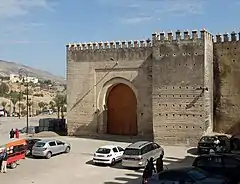

Starting with the Almoravid and Almohad domination of the 11th-13th centuries, most medieval fortifications in the western Maghreb, especially Morocco, shared many characteristics with those of Al-Andalus.[48][1] Many Almoravid fortifications in Morocco were built in response to the threat of the Almohads. The archaeological site of Tasghimout, southeast of Marrakesh, and Amargu, northeast of Fes, provide evidence about some of these. Built out of rubble stone or rammed earth, they illustrate similarities with earlier Hammadid fortifications as well as an apparent need to build quickly during times of crisis.[1]:219–220[11]:299–300 City walls in Morocco were in turn generally built out of rammed earth and consisted of a wall topped by a walkway for soldiers, reinforced at regular intervals by square towers. These walls were characteristically crowned by merlons shaped like square blocks topped by pyramidal caps. Major examples of such fortifications can be seen in the walls of Marrakesh, the walls of Fes, and the walls of Rabat, all of which date essentially to the Almoravids or Almohads.[48][4][26] In western Algeria, the walls of Tlemcen (formerly Tagrart) were likewise partly built by the Almoravids with a mix of rubble stone at the base and rammed earth above.[1]:220 As elsewhere, the gates were often the weakest points of a defensive wall and so were usually more heavily fortified than the surrounding wall. In Morocco, gates were typically designed with a bent entrance.[54][76][48] They ranged from very plain in appearance to highly monumental and ornamental. Some of the most monumental gates still standing today were built in stone during the late 12th-century by the Almohad Caliph Ya'qub al-Mansur, including Bab Agnaou in Marrakesh and the Bab er-Rouah and Bab Oudaïa (or Bab el-Kbir) gates in Rabat.[11][20]
After the Almohads, the Marinids followed in a similar tradition, again building mostly in rammed earth. Their most significant fortification system was the 13th-century double walls of Fes el-Jdid, their capital, but they also built a part of the walls of Salé (including Bab el-Mrissa gate), the walls of Chellah (which include a particularly ornate gate), the walls of Mansoura (near Tlemcen), and a part of the walls of Tlemcen.[1]:318–321 Further east, the Hafsids carried out important works on the walls of Tunis, their capital, once again making extensive use of rammed earth. Bab Jedid, the southwestern gate of the medina, dates from this period in 1276 and generally continues the Almohad format, including a bent entrance.[1]:323 In later centuries, Moroccan rulers continued to build traditional walls and fortifications while at the same time borrowing elements from European military architecture in the new gunpowder age, most likely through their encounters with the Portuguese and other European powers at this time. The Saadian bastions of Fes, such as Borj Nord, are one early example of these architectural innovations.[1][37] As the defensive function of city walls and gates became less relevant in the modern era, city gates eventually became more ornamental and symbolic structures. A prominent example of this is the iconic Bab Bou Jeloud gate built by the French colonial administration in Fes in 1913.[54]
.jpg.webp)
In Morocco, the term "Kasbah" (Arabic: القَـصَـبَـة; equivalent of Spanish Alcazaba) generally refers to a fortified enclosure, ranging from small garrison forts to vast walled districts that functioned as the citadel and center of government in a city (such as the Kasbah of Marrakesh or the Kasbah of Tangier).[4][1][11] Sultan Moulay Isma'il (ruled 1672-1727), for example, built numerous kasbahs across the country which acted as garrison forts to maintain order and control, while also building a vast fortified kasbah in Meknes which acted as his imperial citadel containing his palaces.[1][77] "Kasbah", or tighremt in Amazigh, can also refer to various fortresses or fortified mansions in the Atlas Mountains and the desert oases regions of Morocco, such as the Kasbah Telouet, Kasbah Amridil, Kasbah Tamnougalt, or the Kasbah Taourirt in Ouarzazate.[76] In these regions, often traditionally Amazigh (Berber) areas, Kasbahs are again typically made of rammed earth and mud-brick (or sometimes stone) and are often marked by square corner towers, often decorated with geometric motifs along their upper walls and topped with sawtooth-shaped merlons.[76][78]
Examples by country
The following is a list of important or well-known monuments and sites of historic Moorish architecture. Many are located in Europe in the Iberian Peninsula (in the former territories of Al-Andalus), with an especially strong concentration in southern Spain (modern-day Andalusia). There is also a high concentration of historic Moorish architecture in North Africa (the Maghreb), in Morocco, Algeria, Tunisia, and Libya.
Spain
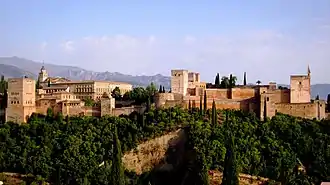
Major monuments
Caliphate of Córdoba (929–1031):
- Great Mosque of Cordoba (founded in 784; significantly expanded in 10th century)
- Alcazar of the Caliphs (no longer extant)
- Medina Azahara (936–1010) in Córdoba
- Mosque of Cristo de la Luz in Toledo (completed 999/1000)
Period of Taifas, Almoravids, and Almohads (11th–13th century):
- Mosque of las Tornerías in Toledo (ca. 1060)
- Aljaferia palace (second half of the 11th century) of the Banu Hud dynasty (1039–1110) in Zaragoza
- The Giralda (1184–98) in Seville, formerly the minaret of the Almohad Great Mosque of Seville (1172–1176)
- Torre del Oro, an Almohad defensive tower in Seville (c. 1220)
Nasrid Emirate of Granada (1212–1492):
- The Alhambra (most significant structures dating from 1338–1390)
- The Generalife (1302–24 in two phases), a country palace initially linked to the Alhambra by a covered walkway across the ravine that divides them
- Nasrid Maristan (hospital) of Granada (1365–7)
- Prayer hall of the madrasa of Yusuf I (1349), located in what is now the Palacio de la Madraza
- Corral del Carbón , a funduq (caravanserai) of Granada (14th century)
- Qaysariyya (bazaar) of Granada (15th century; but destroyed by fire in 19th century and rebuilt in different style)[79]
- Alcazar of Seville, mostly rebuilt under Christian rule but in Moorish style, with the help of craftsmen from Granada[10]
Other monuments
- Alicante
- Antequera
- Alhama de Granada
- Arab baths of Alhama de Granada[80]
- Almería
- Archez
- Bobastro (archaeological site and former 9th-century fortress)[7]:48
- Badajoz
- Bailén
- Baños de la Encina Castle (Burgalimar)
- Córdoba
- Caliphal Baths
- Calahorra Tower
- Synagogue
- "Minaret of San Juan" (930), once belonging to a mosque, now attached to the Church of San Juan de los Caballeros[85][86]
- Gormaz
- Granada
- Albayzín quarter
- El Bañuelo (Arab Baths)
- Dar al-Horra Palace
- City walls and gates (remains from Zirid and Nasrid periods)[87]
- Almoravid minaret at the Church of San José (ca. 1050)[88]
- Almohad minaret at the Church of San Juan de los Reyes[89][7]:112, 212
- Casa de Zafra[90]
- Cuarto Real de Santo Domingo[91]
- Alcázar Genil
- Albayzín quarter
- Fiñana
- Jaén
- Arab Baths of Jaén
- Saint Catalina's Castle
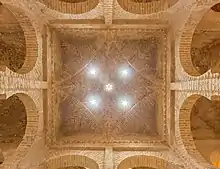 Vaulted and pierced ceiling of the Arab Baths in the Alcázar of Jerez de la Frontera (11th century)
Vaulted and pierced ceiling of the Arab Baths in the Alcázar of Jerez de la Frontera (11th century)
- Jerez de la Frontera
- Alcazar
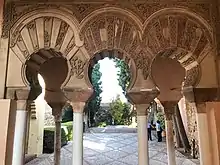 Arches and carved arabesques in a palace at the Alcazaba of Malaga, dating from the Taifa period in the 11th century[7]
Arches and carved arabesques in a palace at the Alcazaba of Malaga, dating from the Taifa period in the 11th century[7]
- Alcazar
- Málaga
- Mérida
- Niebla
- Ronda
- Seville
- Walls of Seville
- Church of San Salvador (preserving traces of the former Mosque of Ibn Abbas on this site, the first city's first great mosque)[94][95]
- Tarifa
- Toledo
- Puerta de Bisagra
- Puerta de Alcántara
- Church of San Román (Mudéjar architecture)
- Synagogue of Santa Maria la Blanca (Mudéjar architecture)
- Synagogue del Tránsito (Mudéjar architecture)
- Trujillo
Portugal

.JPG.webp)

Morocco
- Fez (also spelled "Fes")
- Fes el-Bali ("Old Fes", founded at beginning of 9th century)
- Al-Qarawiyyin Mosque
- Mosque of the Andalusians
- City walls and gates
- Madrasa as-Saffarin
- Madrasa as-Sahrij
- Madrasa al-Attarin
- Chrabliyine Mosque
- Bab Guissa Mosque
- Mosque of Abu al-Hasan
- Madrasa Bou Inania
- Zawiya of Moulay Idris II
- Cherratine Madrasa
- Funduq al-Najjarin
- Bab Bou Jeloud (20th-century gate in local Neo-Moorish style)
- Fes el-Jdid ("New Fes", founded in 13th century)
- Dar al-Makhzen (the Royal Palace; interior not accessible to general visitors)
- Great Mosque of Fes el-Jdid
- Lalla az-Zhar Mosque
- Al-Hamra Mosque
- Marinid Royal Gardens (no longer extant)
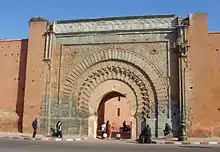
- Fes el-Bali ("Old Fes", founded at beginning of 9th century)
- Marrakesh
- Tin Mal Mosque (at the village of Tinmel)
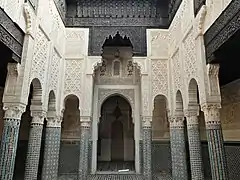
- Rabat & Salé
- Meknes
- Great Mosque of Meknes
- Bou Inania Madrasa
- Kasbah of Moulay Ismail (encompassing many structures in various states of preservation)
- Bab al-Mansour
- Mausoleum of Moulay Ismail
- Taza
- Tangier
- Tétouan (city developed and expanded by refugees from al-Andalus after the fall of Granada in 1492)[4]
- Chefchaouen
Algeria

- Algiers
- Great Mosque of Algiers
- Sidi Ramdane Mosque
- New Mosque of Algiers (mix of Ottoman, European, and Moorish influences)[10]
- Tlemcen (and nearby)
- Nedroma
- Qal'at (Citadel) of the Banu Hammad (ruins in the countryside near M'Sila)
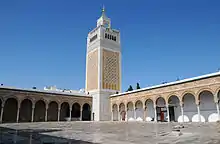
Tunisia
.jpg.webp)
- Tunis
- Great Mosque of al-Zaytuna
- Kasbah Mosque
- Al-Hawa Mosque
- Al-Haliq Mosque
- Zawiya of Sidi Qasim al-Jalizi (or Sidi Qacem al-Zelliji)
- Dar Uthman
- Madrasa Slimaniya
- Madrasa al-Bashiya
- Al-Ksar Mosque
- Hammuda Pasha Mosque (local blend of Ottoman and Moorish/Tunisian styles)[10]
- Kairouan
- Great Mosque of Kairouan
- Mosque of Ibn Khayrun (Mosque of the Three Doors)
- Aghlabid Reservoirs
- Zawiya of Abu al-Balawi (Mosque of the Barber)
- Sousse
- Monastir
- Sfax
- Testour
See also
- Arab-Norman culture
- Islamic influences on Christian art
- Moorish Revival
- Mudéjar Architecture of Aragon
- List of former mosques in Spain
- List of former mosques in Portugal
References
- Marçais, Georges (1954). L'architecture musulmane d'Occident. Paris: Arts et métiers graphiques.
- Parker, Richard (1981). A practical guide to Islamic Monuments in Morocco. Charlottesville, VA: The Baraka Press.
- Gaudio, Attilio (1982). Fès: Joyau de la civilisation islamique. Paris: Les Presse de l'UNESCO: Nouvelles Éditions Latines. ISBN 2723301591.
- Touri, Abdelaziz; Benaboud, Mhammad; Boujibar El-Khatib, Naïma; Lakhdar, Kamal; Mezzine, Mohamed (2010). Andalusian Morocco: A Discovery in Living Art (2 ed.). Ministère des Affaires Culturelles du Royaume du Maroc & Museum With No Frontiers. ISBN 978-3902782311.
- Dodds, Jerrilynn D., ed. (1992). Al-Andalus: The Art of Islamic Spain. New York: The Metropolitan Museum of Art. ISBN 0870996371.
- "moor | Origin and meaning of moor by Online Etymology Dictionary". www.etymonline.com. Retrieved 2020-06-09.
- Barrucand, Marianne; Bednorz, Achim (1992). Moorish architecture in Andalusia. Taschen. ISBN 3822876348.
- Lévi-Provençal, E.; Donzel, E. van (2012). "Moors". In Bearman, P.; Bianquis, Th.; Bosworth, C.E.; van Donzel, E.; Heinrichs, W.P. (eds.). Encyclopaedia of Islam, Second Edition. Brill.
- Gabriel Camps (2007). Les Berbères, Mémoire et Identité. pp. 116–118.
- Bloom, Jonathan M. (2020). Architecture of the Islamic West: North Africa and the Iberian Peninsula, 700-1800. Yale University Press. ISBN 9780300218701.
- Bennison, Amira K. (2016). The Almoravid and Almohad Empires. Edinburgh University Press. ISBN 9780748646821.
- López Guzmán, Rafael. Arquitectura mudéjar. Cátedra. ISBN 84-376-1801-0.
- Giese, Francine; Varela Braga, Ariane; Lahoz Kopiske, Helena; Kaufmann, Katrin; Castro Royo, Laura; Keller, Sarah (2016). "Resplendence of al-Andalus: Exchange and Transfer Processes in Mudéjar and Neo-Moorish Architecture". Asiatische Studien – Études Asiatiques. 70 (4): 1307–1353.
- "Why Moorish? Synagogues and the Moorish Revival". Museum at Eldridge Street. 2017-04-27. Retrieved 2019-11-17.
- Abun-Nasr, Jamil (1987). A history of the Maghrib in the Islamic period. Cambridge: Cambridge University Press. ISBN 0521337674.
- Binous, Jamila; Baklouti, Naceur; Ben Tanfous, Aziza; Bouteraa, Kadri; Rammah, Mourad; Zouari, Ali (2002). Ifriqiya: Thirteen Centuries of Art and Architecture in Tunisia (2nd ed.). Museum With No Frontiers, MWNF. ISBN 9783902782199.
- Rivet, Daniel (2012). Histoire du Maroc: de Moulay Idrîs à Mohammed VI. Paris: Fayard. ISBN 9782213638478.
- Le Tourneau, Roger (1949). Fès avant le protectorat: étude économique et sociale d'une ville de l'occident musulman. Casablanca: Société Marocaine de Librairie et d'Édition.
- Kennedy, Hugh (1996). Muslim Spain and Portugal: A Political History of al-Andalus. Routledge. ISBN 9781317870418.
- Salmon, Xavier (2018). Maroc Almoravide et Almohade: Architecture et décors au temps des conquérants, 1055-1269. Paris: LienArt.
- Basset, Henri; Terrasse, Henri (1932). Sanctuaires et forteresses almohades. Paris: Larose.
- Tabbaa, Yasser (2008). "Andalusian roots and Abbasid homage in the Qubbat al-Barudiyyin in Marrakesh". Muqarnas. 25: 133–146. doi:10.1163/22118993_02501006.
- Deverdun, Gaston (1959). Marrakech: Des origines à 1912. Rabat: Éditions Techniques Nord-Africaines.
- M. Bloom, Jonathan; S. Blair, Sheila, eds. (2009). "Tunis". The Grove Encyclopedia of Islamic Art and Architecture. Oxford University Press. ISBN 9780195309911.
- Kubisch, Natascha (2011). "Maghreb - Architecture" in Hattstein, Markus and Delius, Peter (eds.) Islam: Art and Architecture. h.f.ullmann.
- Bressolette, Henri; Delaroziere, Jean (1983). "Fès-Jdid de sa fondation en 1276 au milieu du XXe siècle". Hespéris-Tamuda: 245–318.
- "The Partal". Patronato de la Alhambra y Generalife. Retrieved 2020-11-28.
- Borrás Gualís, Gonzalo M.; Lavado Paradinas, Pedro; Pleguezuelo Hernández, Alfonso; Pérez Higuera, María Teresa; Mogollón Cano-Cortés, María Pilar; Morales, Alfredo J.; López Guzman, Rafael; Sorroche Cuerva, Miguel Ángel; Stuyck Fernández Arche, Sandra (2018). Mudéjar Art: Islamic Aesthetics in Christian Art (Islamic Art in the Mediterranean). Museum Ohne Grenzen (Museum With No Frontiers). ISBN 9783902782144.
- "Mudejar Chapel of San Bartolomé - Córdoba". Arte en Córdoba. Retrieved 2020-11-21.
- "Royal Chapel | Web Oficial - Mezquita-Catedral de Córdoba". Royal Chapel | Web Oficial - Mezquita-Catedral de Córdoba. Retrieved 2020-11-21.
- "Qantara - Synagogue of Santa Maria la Blanca". www.qantara-med.org. Retrieved 2020-11-21.
- "Qantara - Synagogue de Cordoue". www.qantara-med.org. Retrieved 2020-11-21.
- "Visit Sefardí Museum, El Tránsito Synagogue | TCLM". en.www.turismocastillalamancha.es. Retrieved 2020-11-22.
- ""El Transito" Synagogue in Toledo, Spain". Beit Hatfutsot. Retrieved 2020-11-22.
- M. Bloom, Jonathan; S. Blair, Sheila, eds. (2009). "Hafsid". The Grove Encyclopedia of Islamic Art and Architecture. Oxford University Press. ISBN 9780195309911.
- Bloom, Jonathan M.; Blair, Sheila S., eds. (2009). "Madrasa". The Grove Encyclopedia of Islamic Art and Architecture. Oxford University Press.
- Salmon, Xavier (2016). Marrakech: Splendeurs saadiennes: 1550-1650. Paris: LienArt. ISBN 9782359061826.
- The Rough Guide to Morocco (12th ed.). Rough Guides. 2019.
- Curl p.502
- Pevsner, Niklaus. The Penguin Dictionary of Architecture
- The Industrial Geography of Italy, Russell King, Taylor & Francis, 1985, page 81
- Islam Outside the Arab World, David Westerlund, Ingvar Svanberg, Palgrave Macmillan, 1999, page 342
- Maslow, Boris (1937). Les mosquées de Fès et du nord du Maroc. Paris: Éditions d'art et d'histoire.
- M. Bloom, Jonathan; S. Blair, Sheila, eds. (2009). "Granada". The Grove Encyclopedia of Islamic Art and Architecture. Oxford University Press. ISBN 9780195309911.
- Irwin, Robert (2004). The Alhambra. Harvard University Press. ISBN 9780674063600.
- "Mexuar - Oratory". Patronato de la Alhambra y Generalife. Retrieved 2020-11-22.
- Aboufadil, Y., Thalal, A., & Raghni, M. (2013). "Symmetry groups of Moroccan geometric woodwork patterns". Journal of Applied Crystallography, 46, 1–8.
- Wilbaux, Quentin (2001). La médina de Marrakech: Formation des espaces urbains d'une ancienne capitale du Maroc. Paris: L'Harmattan. ISBN 2747523888.
- "Accommodation in Morocco | Where to stay in Morocco". Rough Guides. Retrieved 2020-05-31.
- Planet, Lonely. "Sleeping in Morocco". Lonely Planet. Retrieved 2020-05-31.
- Terrasse, Henri (1964). "La mosquée almohade de Bou Jeloud à Fès". Al-Andalus. 29 (2): 355–363.
- Bonine, Michael E. (1990). "The Sacred Direction and City Structure: A Preliminary Analysis of the Islamic Cities of Morocco". Muqarnas. 7: 50–72. doi:10.2307/1523121. JSTOR 1523121.
- King, David A. (1995). "The Orientation of Medieval Islamic Religious Architecture and Cities". Journal for the History of Astronomy. 26 (3): 253–274. doi:10.1177/002182869502600305. S2CID 117528323.
- Métalsi, Mohamed (2003). Fès: La ville essentielle. Paris: ACR Édition Internationale. ISBN 978-2867701528.
- Gilson Miller, Susan; Petruccioli, Attilio; Bertagnin, Mauro (2001). "Inscribing Minority Space in the Islamic City: The Jewish Quarter of Fez (1438-1912)". Journal of the Society of Architectural Historians. 60 (3): 310–327. doi:10.2307/991758. JSTOR 991758.
- Frank, Michael (2015-05-30). "In Morocco, Exploring Remnants of Jewish History". The New York Times. ISSN 0362-4331. Retrieved 2020-09-26.
- "Morocco is a trove of Jewish history if you know where to go". AP NEWS. 2019-04-18. Retrieved 2020-09-26.
- Lintz, Yannick; Déléry, Claire; Tuil Leonetti, Bulle (2014). Maroc médiéval: Un empire de l'Afrique à l'Espagne. Paris: Louvre éditions. ISBN 9782350314907.
- Skali, Faouzi (2007). Saints et sanctuaires de Fés. Marsam Editions.
- Reinoso-Gordo, Juan Francisco; Rodríguez-Moreno, Concepción; Gómez-Blanco, Antonio Jesús; León-Robles, Carlos (2018). "Cultural Heritage Conservation and Sustainability Based on Surveying and Modeling: The Case of the 14th Century Building Corral del Carbón (Granada, Spain)". Sustainability. 10 (5).
- Sibley, Magda. "The Historic Hammams of Damascus and Fez: Lessons of Sustainability and Future Developments". The 23rd Conference on Passive and Low Energy Architecture.
- Raftani, Kamal; Radoine, Hassan (2008). "The Architecture of the Hammams of Fez, Morocco". Archnet-IJAR, International Journal of Architectural Research. 2 (3): 56–68.
- Sibley, Magda; Sibley, Martin (2015). "Hybrid Transitions: Combining Biomass and Solar Energy for Water Heating in Public Bathhouses". Energy Procedia. 83: 525–532. doi:10.1016/j.egypro.2015.12.172.
- Raftani, Kamal; Radoine, Hassan (2008). "The Architecture of the Hammams of Fez, Morocco". Archnet-IJAR. 2 (3): 56–68.
- Fournier, Caroline (2016). Les Bains d'al-Andalus: VIIIe-XVe siècle. Rennes: Presses universitaires de Rennes.
- Franco, Ángela. "Citadel". Discover Islamic Art - Museum With No Frontiers. Retrieved 2020-12-25.
- Zozaya, Juan (1992). "The Fortifications of Al-Andalus". In Dodds, Jerrilynn D. (ed.). Al-Andalus: The Art of Islamic Spain. New York: The Metropolitan Museum of Art. ISBN 0870996371.
- Gil-Crespo, Ignacio-Javier (2016). "Islamic fortifications in Spain built with rammed earth". Construction History. 31 (2): 1–22.
- Collins, Roger (1998). Spain: An Oxford Archaeological Guide. Oxford University Press. ISBN 9780192853004.
- "Alcazaba de Mérida". Archnet. Retrieved 2020-12-25.
- Sánchez Llorente, Margarita. "Merida Citadel". Discover Islamic Art, Museum With No Frontiers. Retrieved 2020-12-25.
- "Qantara - Torre del Oro (tower of gold)". www.qantara-med.org. Retrieved 2020-12-25.
- "Walled Cities & Open Societies: Managing Historic Walls in Urban World Heritage Properties" (PDF). UNESCO. 2017.
- M. Bloom, Jonathan; S. Blair, Sheila, eds. (2009). "Seville". The Grove Encyclopedia of Islamic Art and Architecture. Oxford University Press. ISBN 9780195309911.
- "Qantara - Murailles de Silves". www.qantara-med.org. Retrieved 2020-12-25.
- Allain, Charles; Deverdun, Gaston (1957). "Les portes anciennes de Marrakech". Hespéris. 44: 85–126.
- Barrucand, Marianne (1985). Urbanisme princier en Islam: Meknès et les villes royales islamiques post-médiévales. Paris: Geuthner.
- M. Bloom, Jonathan; S. Blair, Sheila, eds. (2009). "Berber". The Grove Encyclopedia of Islamic Art and Architecture. Oxford University Press. ISBN 9780195309911.
- "Qaysariyya of Granada". Archnet. Retrieved 2020-11-22.
- "Arab baths of Alhama de Granada". Portal de Turismo de la Provincia de Granada. 2013-10-02. Retrieved 2020-11-25.
- Ewert, Christian (1971). "El mihrab de la mezquita mayor de Almería". Al-Andalus. 36 (2): 460.
- "Iglesia de San Juan | Almería, Spain Attractions". Lonely Planet. Retrieved 2020-11-25.
- "Qantara - Original minaret of the mosque of Árchez". www.qantara-med.org. Retrieved 2020-11-25.
- "Archez". Andalucia.com. 2011-08-05. Retrieved 2020-11-25.
- "Minaret of San Juan". Archnet. Retrieved 2020-11-25.
- "MINARET OF SAN JUAN". tutto CÓRDOBA. Retrieved 2020-11-25.
- "Walls of Albaicín". Portal de Turismo de la Provincia de Granada. 2013-10-01. Retrieved 2020-11-25.
- "Minaret at Iglesia de San José". Archnet. Retrieved 2020-11-25.
- "Minaret at Iglesia de San Juan de los Reyes". Archnet. Retrieved 2020-11-25.
- "Casa de Zafra. Centro de Interpretacion del Albaicin". www.albaicin-granada.com. Retrieved 2020-11-25.
- "Cuarto Real de Santo Domingo". Portal de Turismo de la Provincia de Granada. 2015-05-11. Retrieved 2020-11-25.
- "Qantara - Église paroissiale de Fiñana". www.qantara-med.org. Retrieved 2020-11-26.
- "Baños de los Arabes (Arab baths)". Andalucia.com. 2011-08-05. Retrieved 2020-11-25.
- The Rough Guide to Andalucia (7th ed.). Rough Guides. 2012.
- "Iglesia Colegial del Salvador/Mosque of Ibn Abbas, Seville". IslamicLandmarks.com.
- "Alcazaba de Trujillo » Castillos del Olvido". Castillos del Olvido (in Spanish). 2016-04-12. Retrieved 2020-11-25.
- "Castillo de Trujillo | Trujillo, Spain Attractions". Lonely Planet. Retrieved 2020-11-25.
- "Zaytuna Mosque | Mosque plan". Archnet. Retrieved 2020-11-22.
Further reading
| Wikimedia Commons has media related to Architecture of Al-Andalus. |
- Marçais, Georges (1954). L'architecture musulmane d'Occident. Paris: Arts et métiers graphiques. – In French; one of the major comprehensive works on Islamic architecture in the region.
- Bloom, Jonathan M. (2020). Architecture of the Islamic West: North Africa and the Iberian Peninsula, 700-1800. Yale University Press. – A more recent English-language introduction to Islamic architecture in the region.
- Barrucand, Marianne; Bednorz, Achim (1992). Moorish architecture in Andalusia. Taschen. ISBN 3822896322. – Overview focusing on architecture in al-Andalus.
- Dodds, Jerrilynn D., ed. (1992). Al-Andalus: The Art of Islamic Spain. New York: The Metropolitan Museum of Art. ISBN 0870996371. – Edited volume and exhibition catalogue focusing on architecture of al-Andalus and some related topics.
- Salmon, Xavier (2018). Maroc Almoravide et Almohade: Architecture et décors au temps des conquérants, 1055-1269. Paris: LienArt. – In French; well-illustrated volume focusing on Almoravid and Almohad architecture. The same author has another volume on Saadian architecture.

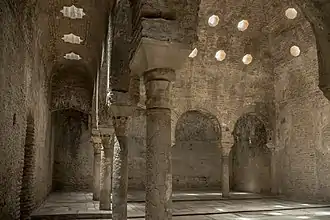
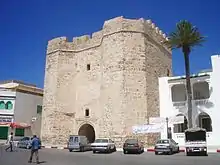

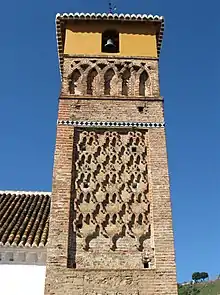
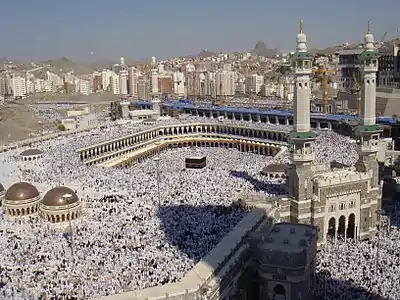
.jpeg.webp)

